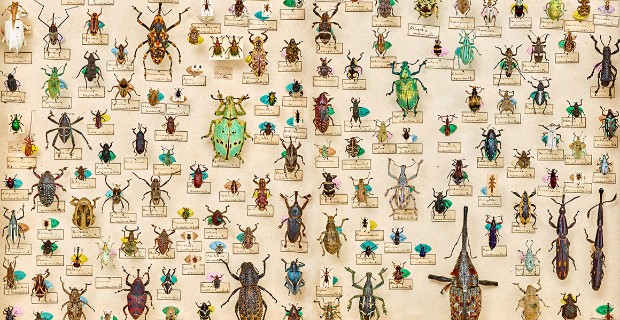Spotting the differences in Galápagos finches
The finches in the above video were collected from the Galápagos Islands in 1835 by Charles Darwin and his colleagues during the second voyage of HMS Beagle (1831-1836).
The different finch species on the islands are closely related to each other, but show wide variations in beak and body size and feeding behaviour.
In particular, changes to the size and shape of the beaks have enabled the different species to specialise in different types of food: seeds, insects, cactus flowers and fruits or even bird blood.
The Galápagos finches are a classic example of adaptive radiation. Their common ancestor arrived on the islands a few million years ago. Since then, a single species has evolved into different species that are adapted to fill different lifestyles.
Darwin didn't recognise the significance of these birds when he first encountered them as he didn't realise how closely related they were to each other. Later, he wrote: 'Seeing this gradation and diversity of structure in one small, intimately related group of birds, one might really fancy that from an original paucity of birds in this archipelago, one species had been taken and modified for different ends.' (Journals of Researches, 2nd Edition, 1845)
Suggestions for use in class
The video above shows six different species of finch found by Darwin and his colleagues on the Galápagos Islands. Overall, there are about 15 closely related species of Darwin's finches.
The video could be used as starter on a lesson on evolution, adaptation and natural selection, or as a part of a discussion on the evidence gathered by Darwin for his theory of evolution.
The video asks: 'Can you spot the differences between these finches?'
The birds differ in plumage and body size but the most obvious differences between the birds are the size and shape of their beaks, which are dependent on their food preferences and specialisations. The thinnest beak belongs to the green warbler finch which uses it to probe for insects. The massive, stout beak of the large ground finch enables it to crush big hard seeds. The long pointed beak of the common cactus finch helps it extract seeds from cactus fruit.
Other questions you could raise with your class after they have seen the video:
- Why do you think the different species have different shaped beaks?
- Molecular evidence indicates that the single ancestor species of the finches arrived in the Galápagos Islands between 2-3 million years ago. Since that time, these volcanic islands have undergone many changes in sea level, elevation and climate. What selection pressures might the finches have faced?
- The HMS Beagle team collected thousands of specimens of plants and animals during their expedition. Why did they do this?

Download finch images
You can download the images used above as a set of zipped JPEGs (1.84MB).

Virtual Evolution Workshop
This live interactive workshop sees your class travel through Earth's history searching for evidence of change over time.
Darwin's mockingbirds
While Darwin’s finches are often associated with his theory of evolution, it was actually his observations of the Galapagos mockingbirds that first sparked his interest in the subject.
Join Randal Keynes, Charles Darwin's great-great-grandson, tells us more:



